Construction Industries Professional Skills Shortage
Info: 11598 words (46 pages) Dissertation
Published: 30th Nov 2021
Tagged: Construction
Table of Contents
Click to expand Table of Contents
1 Introduction into the Research
1.1 Rationale for the Research
1.2 Research Aim
1.3 Research Objectives
2 Literature Review
2.1 Rationale for Literature Review
2.2 Literature Data Sources
2.2.1 CITB
2.2.2 CIOB
2.3 Understanding the UK’s Construction Economics
2.4 Definition of a Skills Shortage
2.5 Skills Gap vs Skills Shortage
2.5.1 Skills Gap
2.5.2 Skills Shortage
2.6 Where is the skills shortage?
2.7 Key effects of a skills shortage
2.7.1 Constraints on Growth
2.7.2 Higher Costs
2.7.3 Reliance of skills from overseas
2.8 Reducing the skills shortage
2.8.1 CITB Levy
2.8.2 Apprenticeship Levy
2.8.3 Vocational Education & Apprenticeships
2.8.4 Government Funded Response Schemes
2.9 Summary
3 Methodology & Research Design
3.1 Introduction
3.2 Statement of Research Aim
3.3 Processes of Research
3.3.1 Qualitative Research
3.3.2 Quantitative Research
3.3.3 Quantitative vs. Qualitative
3.3.4 Triangulation
3.3.5 Outcome of Research
3.4 Methodological Design
4 Data Collection
4.1 Primary vs Secondary Research
4.1.1 Primary Research
4.1.2 Secondary Research
4.1.3 Primary & Secondary Data Sources
4.2 Methodology Design
4.2.1 Stage 1 – Literature review
4.2.2 Stage 2 – Pilot Study
4.2.3 Stage 3 – Main Questionnaire
4.2.4 Questionnaire Delivery & Response Rate
4.2.5 Stage 4 – Data Analysis
4.3 Summary
5 Analysis of Results
5.1 Introduction
5.2 Questionnaire Analysis
5.2.1 Section 1
5.3 Interview Analysis
5.3.1 Background
5.3.2 Skills Shortage
5.3.3 Government Changes
5.3.4 Companies Dealing with Skills
5.3.5 Companies and the Future
5.4 Summary of Analysis
6 Conclusion
6.1 Introduction
6.1.1 Objective 1
6.1.2 Objective 2
6.1.3 Objective 3
6.1.4 Objective 4
6.1.5 Objective 5
7 Recommendations
8 Further work
9 Limitations
10 References and Bibliography
11 Appendix
11.1 Appendix A – Questionnaire Cover Letter
11.2 Appendix B – Online Questionnaire
1 Introduction into the Research
1.1 Rationale for the Research
“The skills shortage that could decimate the construction industry in 10 years.” (Farmer, 2016)
It is predicted that on average 1,800 people leave the construction industry each year. Many are retiring and around 22% of the construction workforce are over 50 years old, with 15% being in their 60’s (Henson, K. and Arsenievich, K., 2014). With the workforce ageing and a poor employment pipeline of young people entering the industry, it would seem inevitable that the sector will soon face a skill shortage crisis. With the construction industry being one of the largest economic contributors in the UK, turning over £103 billion in 2014, accounting for 6.5% of the total economic output of the 2014 financial year. Plus, being a key driver of growth and employing around 2.1 million people in 2015 (Rhodes, C., 2015), it is essential that the sector receives a strong workforce to keep it going at the required output to help re-energise the economy (West, K., 2015).
The Commission for Employment and Skills (UKCES) Employers Report Survey (2016) found the effects of the skills shortage were already prevalent. Stating 209,000 reports of skills shortage related vacancies & approximately 1.4 million staff lacking proficiency in their current role through 2015. But, the consideration of the wider effects has yet to be comprised. (ADD) With the foreseeable challenge of tackling the skill shortage proving evident, the consideration for intervention is heightening and some organisations are now speaking out their solution for tackling this skills shortage. CIOB (2010), CITB (2016) and other sources such as Idox Group (2016) believe that to prevent the complication of a complete skills crisis, more apprentices are required to be employed and the right training is to be provided.
Yet, Agency Central have a worrying insight to the industry skill shortage and show a decline in apprentices between 2013 and 2008. “in the year 2013-2014, there were 8,000 apprentices within the ‘Construction, Planning and Building Environment,’ a figure that has continually dropped for the last five years. In 2008-2009, the number of completed apprenticeships exceeded more than 10,000, showing a 55% decrease since pre-recession statistics.”(Agency Central, 2015) It seems apparent that there is not enough being done to help recruit new personnel into the construction industry and although the Government have been seen to be pushing for a major increase in apprenticeships, is it enough to help make younger people consider the option as equal alternatives to university.
The Idox Group (2016) believes that the industry is to blame with a report called “Mind the Gap: How Can the Construction Industry Tackle Its Skills Shortage” stating that the construction industry needs to start making more of a commitment to recruitment and training. However, impartial to these theories, a joint approach resolution system is seen to be supported repeatedly such as in the CIOB (2010) ‘A Report Exploring Skills in The UK Construction Industry’ and some others. (Boles, 2015)
Through research, the skill shortage has obviously been a problem for a long period within the construction industry, and there have been many attempts to resolve the matter which in turn have turned out to be ineffective (Wakeford, M. 2016). Therefore deeper and more refined research is required on this ever-problematic area within the industry.
1.2 Research Aim
As mentioned in the rationale above, the aim of this research will be to provide professional guidance to the construction industry through reviewing literature & primary data in regards to understanding what can be done to increase employment statistics.
1.3 Research Objectives
The following objectives are specific areas of interest for research:
- To critically explore the background history to the skills shortage within the UK construction industry.
- To critically define the difference between skills gap and shortage, and review through literature which is of higher concern.
- To critically review the response strategies implemented to tackle the skills crisis.
- To critically identify and then evaluate the effects of the skills shortage on the UK economy.
- To critically survey construction professionals to support or oppose the construction industry professional’s skills shortage.
2 Literature Review
2.1 Rationale for Literature Review
This chapter will provide a critical literature review to gather past & present research on both, for and against arguments in regards to the industry doing enough for young people to join trade apprenticeships. Literature will be gathered from electronic sources, books, reports, articles and past dissertation papers to detail contradicting views and theories. By researching deeper, the aim is to find the underlying source of the problem regarding apprenticeship employment and therefore help prevent the trade skill shortage from worsening. In addition, a detailed review will consider past and present government levies & the theories behind vocational education.
2.2 Literature Data Sources
There are two main governing bodies for the UK construction industry, the Construction Industry Training Board & Chartered Institute of Builders. Both bodies provide frequent reports to allow employers and employees overall insights to the industry plus put forward acquisitions of change to the government such as additional funding’s or variations to government policies etc. Both governing bodies can be seen in more detail below.
2.2.1 CITB
The 1964 Industrial Training Act permitted the powers to generate industrial training boards. These boards were responsible for training certain sectors such as the Construction Industry and thus the Construction Industry Training Board (CITB) was created. (CITB, 2017) The CITB (2017) is a partner to the Sector Skills Council in Scotland, Wales & England. They work within the industry to build a qualified workforce through encouraging training in the industry. To help, strategic plans are set out every couple year’s which outline deficiencies within the sector and a clear plan to resolve the issue. From when CITB was created in 1964, the training board has injected over £2.3 billion into the industry through grants to support training & help train more than half a million apprentices. (CITB, 2017)
2.2.2 CIOB
The Chartered Institute of Building (CIOB) is the largest professional body for construction management and leadership. Firstly, it was called the Builders’ Society in 1834 but transferred later to the CIOB in 1980. They were given a Royal Charter to benefit society through promotion of the science and building in construction. Additionally, the CIOB accredits a range of courses including; university degrees, education courses and training.
2.3 Understanding the UK’s Construction Economics
The Office for National Statistics (ONS) (2016) provides details on the current employment statistics. In Sept 2016, 2.2 million people were employed through the construction industry, equating to 6.3% of the total UK employment. With a further 828,000 self-employed in the industry. Rhodes (2015) believes that to truly understand the contribution of any industry, it is best to understand the gross value added (GVA). This is measured by the total of all goods and services less the cost of all inputs and raw materials that are directly attributable to that production (UK Government, 2015). In 2013, the construction industry’s GVA output was £92 billion and in 2014 £103 billion, totalling 6.5% of the total GDP for 2014 (Rhodes, C., 2015). The industry is a powerful driver of growth, delivering £2.84 to the economy for every £1 invested (Ratcliffe, 2012). Details of GVA added between 1997 and 2014 can be seen in the figure …below.
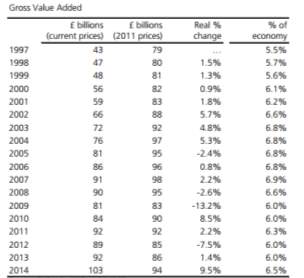
Figure 2: Gross Value Added to UK Economy (Rhodes, 2015)
As seen in the table above, the 2008 to 2009 recession was the largest reduction in GVA for the construction industry and contrary to this, ONS (2017) recorded construction output dropping by 17.9%. A report from Green (2009) highlighted the significant drop in output for the year which led to 170,00 redundancies in this time. The 2009 economic turn had an immediate detrimental effect to the construction industries workforce and has continued to hinder the industry. Figure 4 below conveys the sheer quantity of people continuing to lose their jobs in the industry between Q1 2008 to Q3 2013. As seen in figure 4, construction is the second highest sector for redundancies and job transitions.
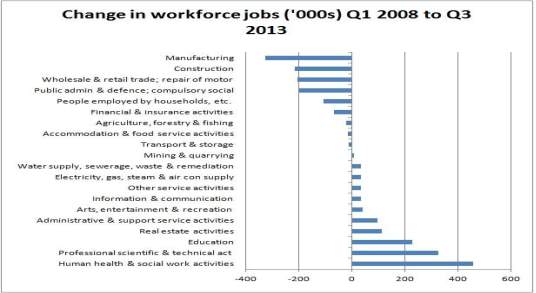
Figure 3: Changes in workforce jobs between 2008 & 2013 (Weldon, 2014)
2.4 Definition of a Skills Shortage
The focus of this research refers to tackling the skills shortage. Therefore, it is essential that the definition is understood. Below defines the outline of the meaning behind the words ‘skill shortage’. The Employers Skills Survey (ESS) defines the skills shortage as “recruitment difficulties caused specifically by a shortage of individuals with the required skills in the accessible labour market.” (Frogner, M.L., 2002.)
2.5 Skills Gap vs Skills Shortage
Whilst conducting research to the common areas of interest around the skills crisis, it has become clear that there is terminology within the literature which may be misunderstood. Therefore, this section seeks to provide conceptual clarity surrounding the terms “skills gap” and “skills shortage”.
2.5.1 Skills Gap
As defined by Merrell (2013), the skills gap is an internal lack of skills or competencies from an existing workforce which in effect does not meet with the organisations requirements. In this case, the term overviews the entirety of the sector and believes that additional training & higher levels of competency is required to meet with construction demands. In support of this, CITB’s “Construction Skills Network” (2012) report mentions that numbers are all too easy to blame when it comes to not keeping up with construction demand. The real issue is the lack of training provided by employers and thus creating a fall in skilled personnel within the industry.
It may also be sort that the rise of graduates in recent years, currently equating to over 12 million (ONS, 2013), will have a positive effect on the gap due to their believed general intellect levels increasing, (Kershaw, 2017). Nonetheless, the Institution of Engineering and Technology (Drives&Controls, 2016) quizzed 400 engineering employers for its 2016 Skills and Demand in Industry report which revealed 62% regard graduates not having the correct skills sets for today’s workplace. Furthermore, a CITB (2014) survey also supports this argument indicating that 80% of respondents cited the cause of hard-to-fill vacancies is that applicants lack the skills required.
2.5.2 Skills Shortage
Contrary to the skills gap view, others such as Schwalje (2011) believe that the industries shortage is within the quantitative amount of personnel currently within the sector and the poor supply chain of people entering. In addition, Davies (2016) speculates that labour force numbers are worrying for the future growth of construction and agrees there is a disproportionate amount of people entering the industry, stating “As 15,000 apprentices don their hard hats every year, over 60,000 are leaving the industry at the same time.” Stocks (2016) also considers believes that the construction sector as a whole is in trouble if we don’t get more people in to the construction industry. Which the RICS (2016) & Gautrey (2016) agree. (FOR ARGUMNET PG 33 HERE) Women have also been a common focus for the construction industries recruitment teams since the millennium but reports have found they still only represent 12% of construction professionals and 1% of working in manual trades.
2.6 Where is the skills shortage?
UK commission for employment and skills (UKCES) reported in 2015 there were 209,000 reported skill-shortage vacancies, an increase of 43 per cent from the 146,000 reported in 2013. However, not all the skilled-shortage vacancies (SSV) have come from the construction sector. Figure 5 below shows what professional SSV are required to be filled within the construction sector for London & the south-east.
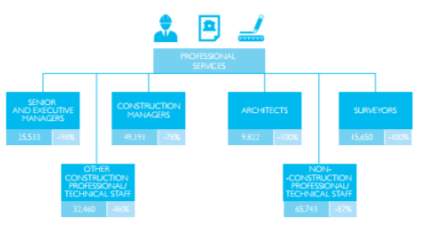
Figure 5: 2015 labour requirement and training deficit for professional services in the south-east and London. (London Chamber, 2014)
Although, figure 5 above only states the SSV requirements for London & the south-east region, the values can be taken and proportionally varied to each region. A mean average of figure 5 above results in the professional services sector requiring an increase of 91.5% in order to eliminate the deficit of professional skills. Figure 6: Survey regarding professionals and if they are concerned that there may not be enough skilled construction personnel when the economy recover. (CIOB, 2013)
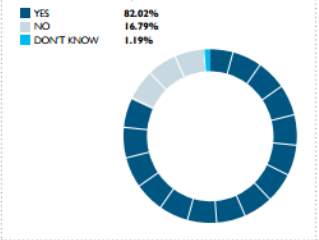
Figure 6 above shows survey respondents responding with 82.02% believing there will be a lack of skilled personnel when the economy recovers.
This is an increase of 5% from the same survey undertaken by the CIOB (2013) in 2011. The Construction Industry Training Board (2016) industry insights article foresees growth between 2016 and 2020. However, this anticipates the skills shortage decreasing and over 230,000 new workers joining over the 4 years. Figure 7 from the CIOB (2016) oversees the forecasted annual amount of construction employment by occupation required over the next five years to meet with housing output forecast for growth, and ambitious Government targets across the UK to increase the volume of available homes by 2020.
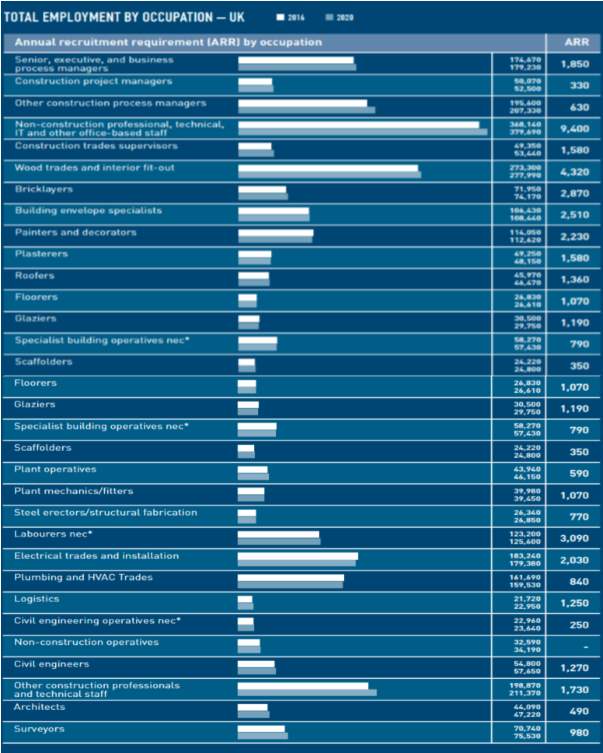
Figure 7: Annual recruitment requirement by occupation. (CITB, 2016)
2.7 Key effects of a skills shortage
This section has critically identified key effects of the skills crisis within the UK economy that have been sort by secondary research. Recent politics have been of interest as well as average UK salaries and business/economy growth.
2.7.1 Constraints on Growth
The direct correlation between growth and the skills shortage is already impeding on the economy. Sally Speed, the skills and talent director at RICS, said “The construction skills crisis is slowing growth in a sector that is vital to the UK” when asked “what effects will the skill shortage have.” (Grant, 2016) A recent report by RICS (2015) resulted in 66% of survey respondents believed that labour shortages were the most significance in regards to their barriers to business growth in the last quarter of 2015. Additionally, the ‘Inspiring Growth’ article by CITB (2015) reported over half of businesses (55%) are not confident there will be enough people available in the future with the necessary skills to fill their skilled jobs.
2.7.2 Higher Costs
Nicola (2016), a recruitment consultant for the industry from Thorn Baker recruitment, recently surveyed construction businesses in Q1 2016 in regards to predicting future workloads. The outcome reported confidence in the sector, revealing 38% of company respondents foresee growing workloads, up 16% from Q1 2015. Growing workloads & higher demand for skilled workers will consequently increase salaries. It is expected that trade, labour & management salaries are to rise by an average of 6% per the RICS (2016).
Measurements made by the Office for National Statistics (2015) has revealed that the 6% rise would add £17,220 to the £287,000 cost of an average UK home. This proves to be a worrying insight. The UK economy salary is currently growing at 2% as opposed to the construction sectors 6% (ONS, 2016). Conflicts between salary growth and construction prices may prove to be more damaging to the small to mid-size construction companies due to estimated small scale private work slowing. The RSA (2017) proves this theory with a survey finding that 756,000 businesses expect revenues to shrink due to a prophesied slowdown in consumer spending.
2.7.3 Reliance of skills from overseas
The struggle of the UK to recruit sufficient skilled staff from the current pool indicates the high reliance on skilled workers from abroad. From figure 4 below, in 2015 there was 7 million foreign-born migrants working within the UK labour market compared to 3 million in 1993. This currently equates to foreign-born people in total employment increased from 7.2% in 1993 to 16.7% in 2015. (Migration Observatory, 2016)
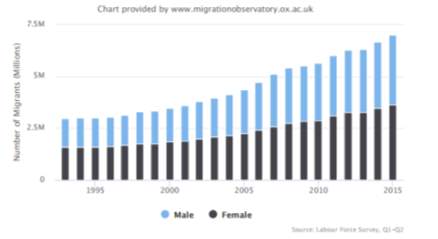
Figure 4: Total number of foreign-born migrants in working age in the UK (Migration Observatory, 2016)
Currently, SuperTemps (2015), a recruitment company for the sector, believes that the fees payed to bring talent from overseas can be less than premium currently payed for skilled workers within the UK, especially if salary inflation continues in the rate. However, Prior (2017) contradicts this argument stating that only 0.2% of Balfour Beatty’s new recruits came from outside the EU in 2016 “due to the complexity, cost, administrative burden and time delays required in managing the current points based sponsor licence system.”
Recent political unsteadiness has given unpredictably to the foreseeable future of migrant workers. Brexit, is in full force with Article 50 to be imposed sooner rather than later with no guidelines to the migrant’s feasibility to stay. (O’Connor and Viña, 2016) In the ‘An analysis on migration in the construction sector’ report by Green (2015), it was detailed that a Labour Force Survey data published in a 2009 report by the OECD put foreign-born employment in construction in 2009 at 228,000. This was about 10% of the workforce.
Evidence from figure 4 provides evidence on the increase of migrant workers by nearly a third over the last 8 years, thus it is probable that they migrants are now a higher percentage of the workforce. Dependant on the outcome of Brexit, this could provide a critical blow to the construction industry. (Howells, 2016)
2.8 Reducing the skills shortage
This section will research what responses the construction industry has seen to slow or rectify the skills crisis. Areas such as government legislation, funding from construction governing bodies and academic implementation will be considered.
2.8.1 CITB Levy
The CITB, distributor of the government levy, provides details to why levy’s and grants are in place. The CITB (2017) explains that with these, it is a helping to ensure the British construction industry has the skilled workforce necessary to produce what is required. The levy covers grants to train new staff and development of the existing workforce, apprenticeships, research into the industry and help develop occupational standards and qualification for the industry. However, an article by Jackson (2016) believes that the CITB is no longer fit for purpose.
Jackson mentions that the problem for the industry is that whilst most of the small & micro enterprises (SME’s) are required to pay towards the 2013 levy, they are not receiving any benefits from it whatsoever and to heighten his argument, the new 2017 CITB Levy will result in large contractors to not have to pay anything, despite their continued allowance for grants and SME’s to pay more. This view is shared by Anfield, (2016) who also foresees the new 2017 levy to contradict the results intended. Nonetheless, a survey by the Department for Business Innovations & Skills (2015) received responses from over 900 construction employers detailed that 73 of 74 large construction employers (250+ employees), the majority of 121 medium construction employers (50-249 employees) and half of 739 small construction employers (0-49 employees) believed the CITB was effective in producing the services detailed in the figure 8 below.
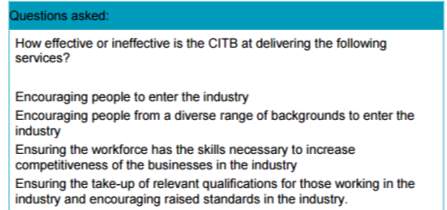
Figure 8: Questions asked to the construction industry regarding the CITB (Gov, 2015)
Additionally, the survey included a question to whether the 2015 CITB could be improved. The results can be seen in figure 9 below.
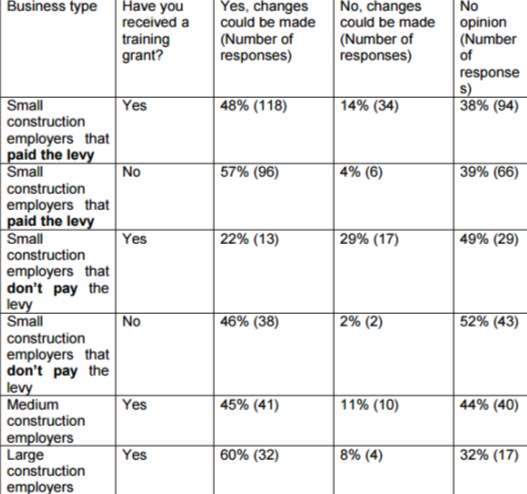
Figure 9: Percentage of businesses (Gov, 2015)
From the table above, it can be seen that a significant number of respondents believe that the levy requires changes to improve the effectiveness and efficiency. This can be seen by most large construction employers & small construction employers who paid the levy and received training. This was viewed the same by just under half of medium sized construction employers. However, respondents that had no opinion to whether changed could be made to improve where a substantial number.
2.8.2 Apprenticeship Levy
As with the CITB levy, the government is introducing an Apprenticeship Levy in April 2017. Employers’ will be required to pay into the levy at a rate of 0.5% of their pay bill. An offset allowance of £15,000 will effectively mean that only employers with a pay bill of over £3 million must pay. (Gov, 2015) The UK Department for Business, Innovation & Skills and HM Treasury (2015) obtained 711 responses for a survey on the implementation of the apprenticeship levy.
Interestingly, a small minority of the respondents believed that only companies that contribute to the levy should be able to access the training support. Therefore, smaller companies would not have access to the funds. However, 353 respondents agreed that a proportion of the funding raised from larger companies should be used to help apprenticeship training costs by smaller companies. The report did however conclude that employers require more detail and training before a true conclusion could be drawn.
2.8.3 Vocational Education & Apprenticeships
Vocational education and training (VET) provides training and education through accreditations in job related and technical skills (NSW, 2016). The system covers the majority of career paths such as trades & technology and can take place at four levels of apprenticeships;
- Intermediate Apprenticeship (Level 2; equivalent to five good GCSE passes)
- Advanced Apprenticeship (Level 3; equivalent to two A-level passes)
- Higher Apprenticeship (Level 4/5; equivalent to a Foundation Degree)
- Degree Apprenticeship (Level 5/6; achieve bachelor's degree) and (Level 7 Masters)
These four levels of apprenticeships aim to cover all levels of skills when related to occupations. The system is not as robust as believed though. The Tomlinson report (2004) outlines that the vocational education system as outdated and changes are required. This is believed by The Guardian (2017) to be a resulting factor of the University Technical Colleges (UTC) push by the government to get more young people into apprenticeships.
The report by Clifton et al (2014) titled ‘Winning the Global Race?’ agrees with the Tomlinson report by stating: “Britain needs stronger and better quality vocational education, coupled with new business models that make better use of workforce skills and enable companies to move up the value chain. This will require employers to engage in a more meaningful way in vocational education and skills development.
Without action in these areas, our economy will not be equipped to compete successfully on the global stage.” Clifton et al (2014) refers to the needs of the UK vocational education system to be improved due to the believed additional 3.6 million medium-skilled occupations by 2022. The 3.6 million includes professionals in health, skilled trades and public services, all of which employ large amounts of level-3 and level-4 vocational qualifications and apprenticeships. A finer detailed breakdown of the jobs required by 2022 can be seen in the figure below.
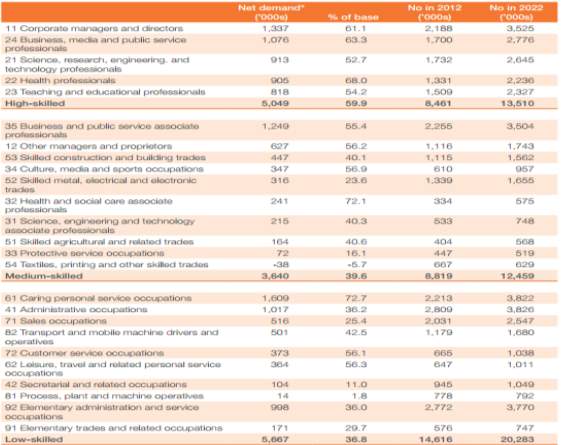
Figure: Net demand by occupation category (Wilson et al, 2014)
The data presented above has important implications for the vocational education system. It is clear that the jobs market will continue to professionalise and that in the future there will be strong demand for people with degrees. Positively, Universities across the UK are currently at record levels, with the acceptance of new students in 2015-16 reaching 532,300 (UCAS, 2015), and the rate of employment at 87.1% (Gov, 2016).
Clifton et al (2014) perceives policymakers to be giving more attention to the higher education but believes this is the right thing to do due to the likely potential of higher education helping drive skills, growth and social mobility. However, Green (2017) sees that this trend should not be exaggerated as there is also expected to be substantial demand in the lower and middle half of the occupational ladder. Interestingly, The Guardian (2017) give credence that apprenticeships and vocational educations status will only improve when it is not seen as the preserve of those who have been failed by the school system.
2.8.4 Government Funded Response Schemes
In the following sub-sections, four of the highest popularity schemes that are funded by the government through the CITB have been presented. The strategies focal points range from gender equality, younger people and ex-service personnel to change the image of construction and thus gain potential sources of new entrant trainees to reduce the UK construction industries skills shortage.
2.8.4.1 Built by Her
Built by Her is an initiative created by Marta de Souza a property developer / expert. The schemes focus is on increasing the quantity of women in construction and changing the face of the construction industry, making it accessible to women. The target is to entice 12-18-year-old young women by presenting the opportunities as apprenticeships available within the construction industry. The scheme works through a national government backed advertising campaign, developed by Mr. President and work alongside Inspiring the Future. (De Souza, 2015) Gurjao (2014) is convinced that younger women, returning women & women considering a career change are the missing key to reducing the skills shortage. Miller (2016) agrees with Gurjao by stating; “it is my belief that females are instrumental to the growing success of the sector.” Nonetheless, an article written by Jones (2005) called “Construction: no place for a women!” directly quotes Knowles, R. in a letter published by Building on his interpretation that “If I offered 50 women a job in construction, most would say ‘No to a construction job.” The Equal Opportunities Commission report (2014) collaborates with Knowles’ argument with a survey on school-age girls with 80% of respondents stating they would be interested in learning to do a non-tradition job; however, only 12% were interested in construction.
2.8.4.2 Go Construct
The campaign ‘Go Construct’ was developed in 2015 to help fill the sectors increasing demand for labour (CITB, 2015). In order to gain a true understanding of the requirements, the campaign has drawn influence from over 141 contractors, academic organisations & construction governing bodies. To run the campaign, a grant by the CITB has awarded ‘Go Construct’ funding for the value of £5 million over 3 years. Wilkinson (2016) from Skills Planner agrees with the motion of developing new recruitment initiatives, as the industry is currently facing a major skills shortage but many of which campaigns are separately engaged in similar, but often disconnected, aims. Contrary, ‘Go Construct’ (2017) quotes that their site “helps to meet the future skills needs of the industry…” and recent research by Thomas (2016) has supported this with a survey of attendees of ‘Go Construct’ resulting in one third of men (35%) and 29% of women surveyed got a better job as a result of training, and 18% of men and 12% of women received a promotion.
2.8.4.3 Get into Construction
The ‘Get into Construction’ scheme by BuildUK is another initiative supported by the government in an attempt to highlight the prosperous industry of construction to young people. (Pretty, 2017) Again, the scheme collaborates will schools and colleges to help show career opportunities and incentivising slogans such as “whatever you are into, get into construction – you won’t regret it.” by Nichol (2016), Chief executive of BuildUK.
2.8.4.4 Build Force
Every year, around 20,000 men and women leave the armed forces (Jarvis, 2013). Many have acquired leadership skills, faced challenging environments and been demanded for strong collaborative work (Dinnen, 2012). These experiences are believed to ideally suit the construction industry and that is where ‘Build Force’ comes in. ‘Build Force’ is new recruitment initiative by the CIOB & funded by the CITB whom actively seek ex-forces men and women to join the construction industry at a trade level with the potential for early progression to middle management. (CIOB, 2016) Ex-servicemen, Toy (2016) considers this a brilliant initiative and wished he had something like this in his day. A clear indication of effectiveness which others such as CIOB (2016), REC Solutions (2016) & GCR (2016) also believe.
2.9 Summary
The chapter above has identified the direct correlation between the UK economy and the UK construction industry whilst identifying areas for animadversion when it comes to the skills shortage. The literature has proven that this crisis is not a present problem but one of great maturity and although past initiatives have not provided what was intended, more recent ones are seen to be positive and conceded. The research has also led to prove the construction industries worth to the economy and how influential the effects of the skills shortage are. Not only is the skills shortage affecting the construction industry directly but small businesses, the general public and the UK economy are all indirectly affected with costs, growth and labour resources.
3 Methodology & Research Design
3.1 Introduction
This chapter sets out the methodology and research process used to achieve the research aim.
3.2 Statement of Research Aim
The aim of this research is to provide an insight into the reasons why the younger generative pursue a career within the construction industry, and understand what effects the skills shortage is having.
3.3 Processes of Research
3.3.1 Qualitative Research
Qualitative research is ‘subjective’ in nature (Naoam, 2013). This type of research is known to draw understanding from a subject and take appreciation of basic causes and principles, notably, behaviours (Fellows & Liu, 2015). It enables the respondent to provide emphasis in their views through descriptions and experiences etc. Qualitative research can be classified under two types of research; exploratory and attitudinal.
3.3.1.1 Exploratory
Exploratory research is used where the knowledge of the topic is limited (Naoum, 2013). It aims to provide insight and familiarity for the research subject area. Exploratory research was essential in providing understanding into the UK construction industry and has resulted in the ability to understand the diagnostics of the situation, screening alternatives and the emergence of new ideas (Zikmund, 1997).
3.3.1.2 Attitudinal Research
Attitudinal research is used to obtain a focal view or opinion, or ‘perception’ of a person, towards a particular object from the respondent’s (Naoum, 2013). I.e. An opinion on the CITB Levy.
3.3.2 Quantitative Research
Quantitative research is ‘objective’ in nature (Naoam, 2013). The data collected is hard and reliable; measurements of tangible, countable, sensate features of the world (Bouma and Atkinson, 1995). The research is collected against a theory of social or human problem, through the measurement of statistical evidence to verify a truth in a hypothesis or theory rather than develop it (Creswell, 1994). Quantitative research can be compiled in the following examples (Klazema, 2014):
- Experiments
- Sampling polls, Questionnaires & Surveys
- Measurement
Quantitative research entails reasonably fast data collection from a large sample group with the analysis of data also easily understood due to its statistical nature. Furthermore, random sampling can take place to provide validity and the results to then be generalized beyond the initial participant group (Sheragy, 2017). With the ability to generalize beyond the focal group of participants, quantitative research has the potential to collectively gain the view from the further construction industry. With this in mind, quantitative research will be used within the research.
3.3.3 Quantitative vs. Qualitative
Quantitative and qualitative research have both indicated areas of contrast. The aim is to balance out the indifferences through the triangulation theory and improve accuracy on the judgment of research by collecting both kinds of data bearing on the same aim (Jick, 1979). Bryman (1988) provides a useful list of differences that triangulation will intend to eradicate. These can be seen in the figure below.
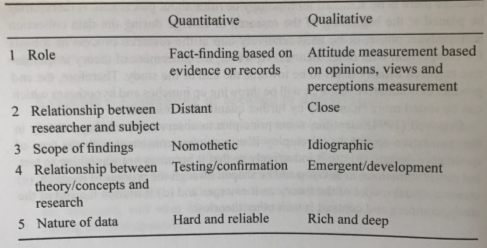
Figure: Some differences between quantitative and qualitative research. (Source: Bryman, 1988. p48)
3.3.4 Triangulation
Campbell and Fiske (1959) believed that in order to ensure that the variance reflected is that of the trait and not the method, ‘multiple operationism’ also known as triangulation should be used to provide such. Figure…. Below shows how quantitative and qualitative research is designed when using the triangulation theory.
 Figure: (Fellows & Liu, 2015) Cohen et al. (2011) describes that the method of blending research techniques is to study one thing; “[Triangulation is an] attempt to map out, or explain more fully, the richness and complexity of human behaviour by studying it from more than one standpoint.”
Figure: (Fellows & Liu, 2015) Cohen et al. (2011) describes that the method of blending research techniques is to study one thing; “[Triangulation is an] attempt to map out, or explain more fully, the richness and complexity of human behaviour by studying it from more than one standpoint.”
The use of triangulation also buffers out the limitations that can be associated with a single method approach and thus will be applied methodological approach for this research.
3.3.5 Outcome of Research
As spoken by Collis (2009), standard classification of research projects can be divided into either ‘applied research’ or ‘basic research’. In regards to the research conducted, basic research will be of more interest due to the nature of development and refinement towards a theory. Applied research is conducted for the purpose of applying or testing a theory and evaluating its effects, which does not suit the research aim. (Zamar, 2015)
3.4 Methodological Design
In selecting a research strategy, the nature of the perceived connection between theory and research implied by the research aim, as well as epistemological and ontological considerations, will be influential, as quantitative and qualitative research strategies differ greatly in each of the respects (Bryman, 2004). Whilst designing the methodological design, key areas such as the validity, transferability, replicability and generalisability are of high importance and reflect the data outcome (Leung, 2015). Winstanley (2009) supports this view and provides definition to each:
- Valid – Well founded, convincing and justifiable, demonstrated through using consistent and object research methods.
- Transferable – The principles can be translated into different contexts.
- Replicable – The method chosen should be able to be recreated.
- Generalisable – General principles can be drawn from the specific investigation.
She further states that these “aspects of a research question need to be taken into account if the research is to be taken seriously.”
4 Data Collection
“Data collection is available through many different methods.” (Bowen, 2017) This chapter will identify methods of data collection and the justification for the researchers’ method of choice.
4.1 Primary vs Secondary Research
4.1.1 Primary Research
Primary research is described by Noam (2013). as information newly collected by the researcher. This data is also known as ‘raw data’ meaning the data has not been processed by selective extraction, organization, and sometimes analysis and formatting to make it presentable. Rouse (2009) also explains that it is very difficult to gain raw data through secondary research. A disadvantage to primary research is that it can be expensive to obtain, very time consuming and potentially not to the depth of some secondary data.
4.1.2 Secondary Research
Secondary research, also known as a desktop study, is the form of data that is extracted from pre-produced information, such as; existing literature and official statistics (Naoum, 2013). Secondary research has benefits such as time, cost and practicality. However, the data is not always taken from the source, which therefore provides opportunity for details to be composed in a fashion to which the viewers wants to see (Johnston, 2014).
4.1.3 Primary & Secondary Data Sources
The table below details some of the methods primary and secondary data can be collected.
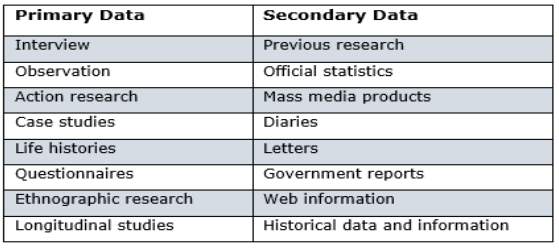
Table 1: Primary and secondary data resources (composed from University of Surrey, 2017)
4.2 Methodology Design
The methodology of this research can be seen in figure below.

Figure: Methodological design structure of the research Stage 5 – Should be writing (Source: Author)
4.2.1 Stage 1 – Literature review
An initial literature review detailed the focal area for the research. Once understood, a critical literature review could be undertaken to identify the severity of the construction industry skills shortage, the present effects that had been felt by the industry and what had been implied to help reduce this. A literature review by Naoum (2013) explains that it serves two purposes; One, that it develops themes and issues within the research and two, the study will be improved due to the understanding of previous research on the selected area of interest. From the literature, the researcher could clearly allocate an aim and objective that was suitable for the scale of the research, and crucially, deliver the research aims.
4.2.2 Stage 2 – Pilot Study

Once the literature was complete, a pilot study in the form of a questionnaire involving Sienna Contractors Ltd, was conducted. Hopper (2011) believes that pilot studies are incredibly relevant for development work to which Bell (1996) agrees. Bell continues, a pilot study is a trail run of questionnaire which involves; the testing of the wording of questions, identifying ambiguous questions, testing the data collection technique, measuring the effectiveness of the invitational method and so on. Additionally, Bell (1996) goes further and states that the following questions in figure… should be asked to the respondents; Figure:…. (Source: Bell, 1996)
4.2.2.1 Pilot Questionnaire
For the pilot study, an online questionnaire was sampled at Sienna Contractors Ltd, 5 professionals at the company ran through the questionnaire independently. The varying professions of the respondents abled the researcher to generalise the answers across a wider sample audience. From the analysis of the pilot interview’s, it could be considered that the questions within the research were clear and had a focus to tackling the researchers aims. Coinciding with the presumed benefits detailed by Bell (1996). Additionally, many answers from the interviews gave support to the literature previously researched and cleared that there was no accidental inclusion of ambiguous questions. As to the result of the pilot study, minor variations to the questionnaire were made such as changing some questions from closed to open to allow the respondent to provide depth to their argument. A full breakdown of the changes can be seen in appendix ….
4.2.3 Stage 3 – Main Questionnaire
This section will provide an overview of the main questionnaire design. It will incorporate some of the questions used, how the research was conducted, the target sample and the response rate.
4.2.3.1 Stage 3.1 – Online Questionnaire
The research obtained primary data through an online questionnaire. The questionnaire was hyperlinked within an email to which was sent to the researcher’s sort address book of construction professionals. The use of an online questionnaire was due to the advantages described by Wright (2005). The considered advantages of an online questionnaire are:
- Access to Unique Populations
- Time Saving
- Low Costs
In addition to the advantages above, respondents of the questionnaire were not required to return the envelope to a post-box but just used the weblink included within the cover email. (Please see Appendix A)
4.2.3.2 ‘Survey Monkey’
‘Survey Monkey’ is an online software which allows a user to create an online questionnaire and distribute using a composed web link. This website is well known, has many reputable reviews and also allows the user to analyse data efficiently. This ensured a profession structured questionnaire was produced.
4.2.3.3 Questionnaire Design
For the research aims and objectives to be achieved, the questionnaire was created to be semi-structed with the use of open and closed questions. Although, initially intended to have a split quantity of open and closed question, the pilot interview expressed restricted time for the professionals and resulted in a majority closed ended question questionnaire. Fellows & Liu (2015) explains that open ended answer can result in shallow answers if time is limited. However, some questions will be left open to help draw depth to an answer. The questionnaire was 20 questions in total and split into five sections. The respondents were initially asked for details such as their professional, organisation size, region(s) of work, method of entry to the industry and what sectors within construction they work in. This helps the researcher with validity, generalisability and reliability of the data input. Once personal details are completed, the questionnaire follows on by asking questions regarding the research objectives. The questionnaire layout can be viewed in Appendix B.
4.2.3.4 Linkert Scale
(ADD)
4.2.3.5 Research Ethics
The Oxford Dictionary (1976) defines ethics as: ‘Relating to morals, treating of moral questions; morally correct, honourable… Set of principles of morals… Science of morals, moral principles, rules of conduct, whole field of moral science.’ Ethics must be considered when composing research of any kind. The ‘Research Ethics Policy’ from Nottingham Trent University (2017) has been adhered to by the researcher along with the Economics & Research Council (2017) ethics framework.
4.2.3.6 Research Sample
For the purpose of this research, the use of purposive sampling has been chosen. Purposive sampling is a non-probability sampling method and it occurs when elements selected for the sample are chosen by the judgment of the researcher (Black, 2010). In this instance, the aim of the research is a professional skills shortage within the construction industry and as a result of this, the element of focus is on working construction professionals as to their first-hand experience surrounding the objectives. Thus, mitigating the use a random sampling technique. In order to select construction professionals, various previously known companies and companies found through the top 100 UK contractors index were contacted via telephone and made aware of the research to be conducted. As a result, participants came forward to be a part of the research. An example can be found in Appendx (…..) 100 emails were then composed and sent to the construction professionals opting to participate.
4.2.4 Questionnaire Delivery & Response Rate
Questionnaires were sent out to 100 participants who opted in to taking part of the survey. A hyperlink in the covering email detailed instructions on how to get to the survey along with a requested completion date of the 15th March. The response rate for this research after the allotted time equated to 26% (return of 26 questionnaires). The following sub-sections categorise the respondents.
4.2.4.1 Job Titles
The sample of respondents were in line with the study sample model. Figure … below details the respondents by profession. It is believed that the split of professionals shall draw a varied response to the questionnaire as it is foreseeable for professionals working directly on site will view the skills shortage differently to those in positions of higher authority such as a commercial director.

4.2.4.2
Age Category
Of the 26 respondents, the highest age group percentage, 27% (7 respondents) were within the 55+ age group. This correlates with the literature review finding of an old age workforce. However, 19% were within the 19-24 age group which positively reflects the push for the recruitment of the younger generation.
4.2.4.3 Company Size
The sample represented a good split between company sizes with large companies (250+ employee’s) responding the highest at 38%. (Figure ….)
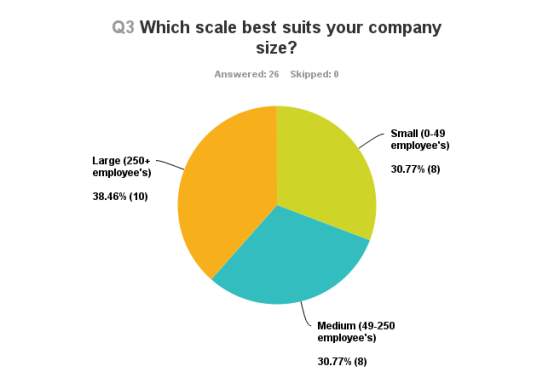
4.2.4.4 Regions of Work
England is divided into nine governmental regions. Respondents were asked to a select a region or region’s they work within to allow for categorisation. Figure … below defined the regions within the UK. Figure .. – Defined regions of work

(Source: Barrow, 2013)
As seen from figure… below, Greater London is the most worked in region with Wales being the smallest from the sample group. However, the 26 respondents have provided a good spread of working locations.
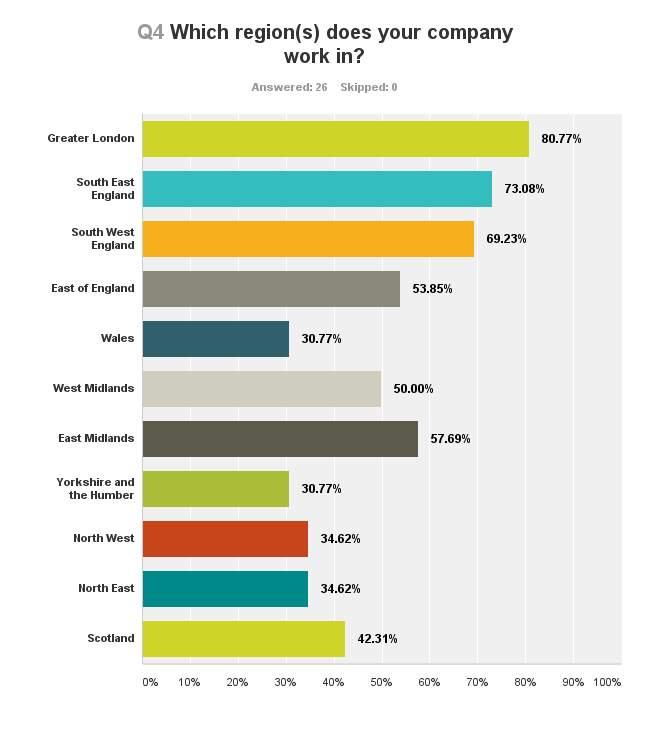
4.2.4.5 Sectors of Work
The Cabinet Office (2011) describe the three general sectors of work within the UK construction industry are;
- Commercial & Social
- Infrastructure
- Residential
These categorise were used to understand the participants working background. Multiple selection was possible due to the broad working areas of some professionals. Additionally, an ‘other’ answer was incorporated for any sector missed. Figure… below highlights that the sample were almost equal with the sectors of work but with residential the highest.
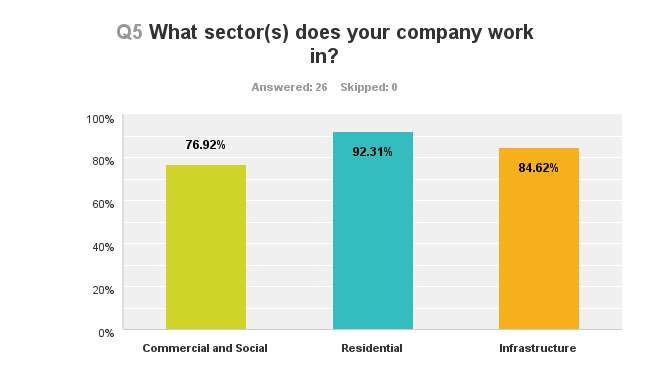
4.2.4.6 Entry into the Industry
Entry into the industry was another category within the research. Interestingly, grad schemes were the highest method of entry to the industry with transferring from another sector closely behind. Figure … below details the respondents answers.
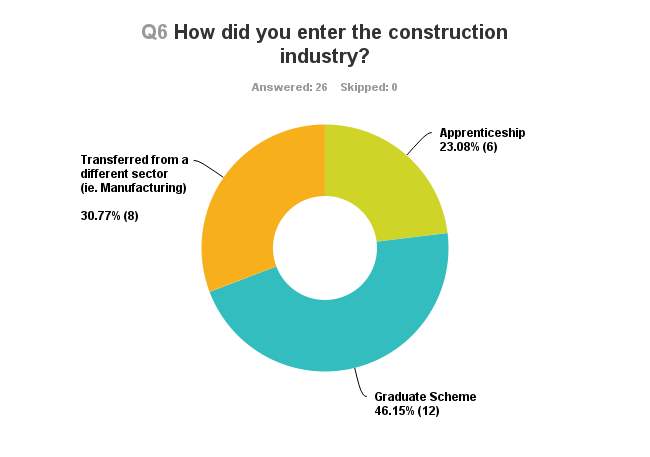
4.2.5 Stage 4 – Data Analysis
Prior to the analysis of data, the raw data was collated into a data summary form. (See Appendix ….) Open-ended questions provide qualitative answers. These responses are required to be categorised and coded into themes to allow for the data to be quantified. Once quantified, the data is then measurable and comparable to other quantitative data. The ‘Descriptive Statistics Method’ was chosen to analyse the data. Noaum (2013) states that this method can provide a general overview of the results and is the simplest method of analysis. This method breaks the information down into a comparable number or statistic, dependant on the sample size. The results are then to be reviewed against the findings within the literature review.
4.2.5.1 Stage 5 – writing the research project
This stage entails completing the write up of the dissertation.
4.3 Summary
The collection of data has now been achieved through the methodological process described in the data collection chapter. The data is for the most part in the form of ‘closed’ questions and thus quantitative data. The few ‘open’ questions providing qualitative data have been subjected to categorisation and as a result, all data can now be analysed further.
5 Data Analysis
5.1 Introduction
This chapter will review the primary data obtained from the 26 online questionnaire respondents (See appendix …). This data will then be analysed against the literature review findings.
5.2 Questionnaire Analysis
The responses for ‘general information’ questions (no. 1-6) can be found in this section of this study. These questions were designed by the researcher to ensure the sample participants met with the aims of the research and that a broad level of profession, age, company size, region of work, working sector and entry to the construction industry in achieved.
5.2.1 Section 1
5.2.1.1 Q7
Which answer below do you believe best suits this statement "There is a skills shortage within the construction industry."
In order to gain an initial insight into the respondent, the above question was asked. The Likert scale gave a degree to the belief or disbelief of the statement. Table … below displays the results.

Responses to the statement shows that 38.5% of respondents agree that there is a skills shortage within the construction industry and 61.5% strongly agree. To reflect on previous studies, the answers have been further categorised into a simple ‘yes’ or ‘no’. This can be seen in table… below.

In comparison to the 2013 CIOB survey which resulted in 82% believing the construction industry had a skills shortage, this study obtained 100%, an increase of 18%. Additionally, this was 23% increase from the 2011 CIOB survey. The degree of the responses was unable to be compared to any other literature or survey found. However, the analysis concluded that this supported the literature found. Reflecting on the considerations for change gives the researcher good background to believe that the 18% increase is down to the UK economy & construction industries continuation to reverse the effects of the recession. As stated by the CITB (2016). This respondents to the question came from varied working construction professionals and sees that no variable such as location, age etc affects the categorised decision.
5.2.1.2 Q8
Which skills do you believe the industry lacks the most?
General research surrounding the skills shortage had indicated that the construction industry has mostly reported a trades skills shortage. The surveyed results can be seen in figure … below.

An equal lack of both skills received the highest vote at 69% with only 1 respondents believing it to be professional skills and just 7 for tradesman. In order to reflect on the literature, a combined analysis approach (see table.. below) was used to combine the answers of ‘equal’ with the professionals & tradesman answers. This resulted in the sample responses aligning with the literature stating the construction industry lacked skilled tradesman the most.
Additionally, the CITB (2016) produced an annual recruitment requirement table, found in chapter …. (Figure …), which was summarised into professionals, tradesman & others to further analyse the comparisons between this study and other literature. (Please see table .. below.)
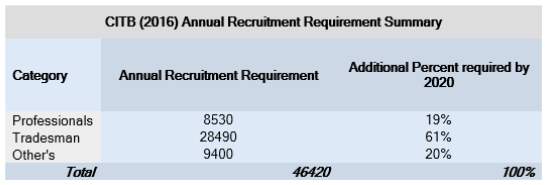
Surveys from the CITB (2016), CIOB (2013) & UKCES (2015) match with the findings of the researcher’s survey as to such that tradesman are the most lacking skill in the construction industry. However, there is also differentiation to the CITB (2016) survey, with required professional skills 42% lower than required trade skills and thus does not correspond with the 68% seen in this study for equal lack of skills.
5.2.1.3 Q9
Which would you consider to be the main effect of the shortage on the industry?
Highlighted in the literature review, many reports incorrectly use the terminology of ‘skills gap’ and ‘skills shortage’ in the support of an opposing argument. This question, along with the summarised definitions allowed the study sample to accurately consider the main effect of the shortage to the industry. The results can be seen below in figure…. .
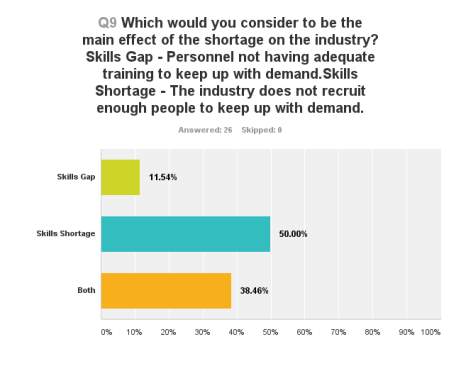
13 responses, equalling to 50% of the votes viewed the main effect of the shortage to be down to the industry not being able to recruit enough people to keep up with demand. The respondent’s majority view supports Schwaljie (2011) in that the quantitative amount of personnel & poor supply chain are to be the main cause, and contradicts the CITB (2012) Construction Skills Network report stating a lack of training provided by employers were to blame. 38% of the sample did however view both the ‘shortage’ and ‘gap’ to be the cause which would indicate that although it is slightly a quantitative matter, not enough sufficient skills are also considered for blame.
5.2.1.4 Q10
Recent reports have highlighted a growing UK skills crisis in the construction industry. Which of the following statements best suits your company?
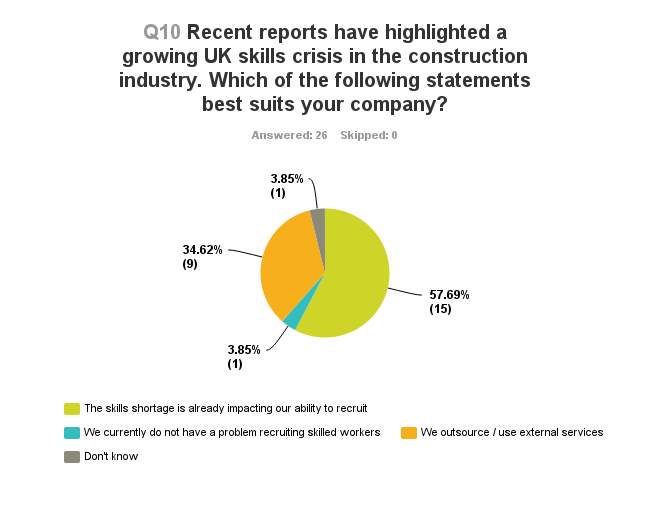
This question explored the ability of the respondent’s company to recruit skilled workers. The study unveiled that 58% of respondents already felt their ability to recruit was being affected by the skills shortage whilst 35% used outsourcing for their recruitment. Although over a third of respondents used external services for recruitment, the Recruitment and Employment Confederation (2017) highlighted recruitment agencies were also struggling to fill vacancies. As a result, table .. below has incorporated ‘outsourcing’ and ‘already impacting ability to recruit’ in the same category.

The summarised results did not however coincide with literature findings. The ‘impacted ability to recruit’ response accounted for 24/26 votes which went against the literature review findings of The Federation of Master Building (2016) survey indicating only 14% of firms reported a drop-in employment levels & 67% reporting no change in Q4 2016. In comparison to the study sample only 3.8% responded with no affects to their ability to recruit & 3.8% who were not sure. A pre-empted view by the researcher considered what characteristics would form a difference between those who ‘outsource / use external services’ & those already impacted with recruitment problems. This was that SME’s would generally recruit more & larger organisation use mainly outsourcing. However, this was not discovered from the sample group. Table … below details the findings by scale of organisation.
5.2.1.5 Q11
What effect has the skills shortage had on your company?
One of the key objectives of the study was to look at the effects the skills shortage is having on the construction industry and the UK economy. This question delved into the present effects felt by construction organisations. Figure.. below details the findings.
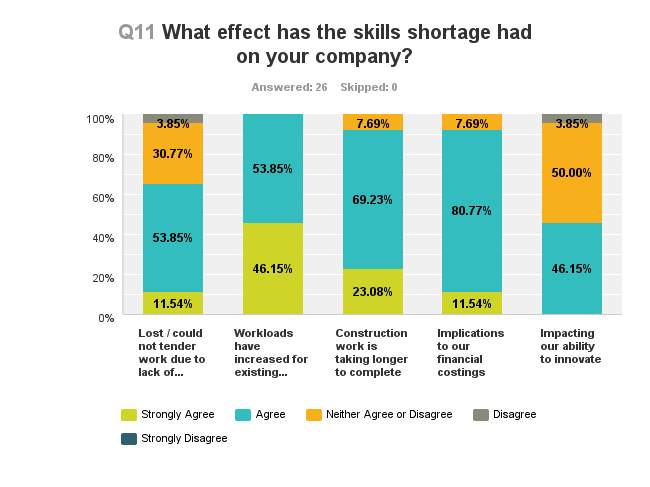
The study results above have been analysed below. ‘Implication to our financial costings’ 81% of the respondents agree that the present skills shortage has had a financial impact on their organisation with a further 12% strongly agreeing with this statement. 8% of respondents neither agreed or disagreed with this point. From the table above, the relationships between the widely reports skills shortage and an increase in financial costings is clearly present. This corresponds with the CITB (2014) survey ‘half of employers with hard to fill vacancies have cited an increase in operating costs’. ‘Workloads have increased for existing staff’ This response collected just under half of all recipients strongly agreeing that workloads have increased as an effect of the skills shortage and a further 54% also in agreement. This statement received no responses for a disagreement or neutral stance to the increased workloads. The study findings reflect similarities to the 38% of respondents foreseeing growth of workloads in the Thorn Baker (2016) report. It could also be considered that the increase in workloads is affecting the pre-empted 6% rise in salaries per the RICS (2016) review.
‘Construction work is taking longer to complete’ Another effect of the skills shortage which the study sample highly agreed upon is that construction work is taking longer to complete. 69% of respondents agreed to the statement and 23% strongly agreed. The findings showed that no respondents disagreed with the effect. Construction industry market analysis providers, Glenigan (2016) also concur with the results of this study, stating construction work is slowing due to the skills shortage within the residential sector. Similarly, the study results proved that the sector with the most agreeing respondents was residential. The results can be found in table… below.
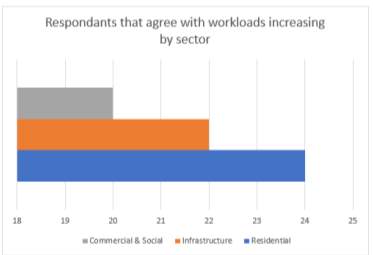
‘Lost / could not tender for work due to lack of employee’s’
Further to the effects already analysed, lost or could not tender for work due to lack of employee’s as a result of the skills shortage received 65% of respondents agreeing with only 1 respondent disagreeing and 8 respondents who were impartial. In reflection to the literature review findings, these results are primarily down to the workloads increasing and thus limiting the organisations capacity to continue taking on new work. (RICS, 2016)
‘Impacting our ability to innovate’
The effects on a company to innovate was the lowest factor in terms of responses in agreement. However, it still received agreement from just under half of the respondents. The other half of responses were neutral in their view and only 1 participant disagreed with the skills shortage effecting innovation. In the literature findings, the Farmer (2016) review indicated that the construction industry’s needs to increase innovation. With this in mind, innovation has not played a large role in construction for many years and thus the respondents received could be potentially down to lack of understanding to the term or that the positions held within an organisation does not require them to innovate.

Table … above shows the study samples highest overall felt effect to the skills shortage. The results show the severity of the effects felt with workloads increasing at the top and ability to innovate at the bottom. However, they are all relatively similar.
5.2.1.6 Q12
Do you believe that the 2015 CITB levy is effective in ensuring training, education & apprenticeships are provided by construction employers?
On the CITB (2017) main page, it is described that the CITB levy ensures training, education and apprenticeships are provided. Although this may be true, literature findings report that the levy is top down managed and does not understand the requirements of employers. Q12 results can be seen below in figure….
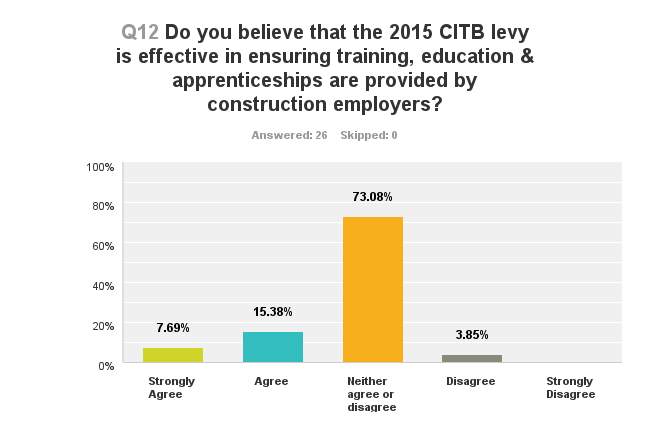
The results clearly display the majority of respondents, equating to 73%, do not agree or disagree with the statement in question. It is however
5.2.1.7 Q13
Do you believe the new 2017 CITB levy will help to provide a positive improvement on the current CITB levy?
Following on from Q12, the CITB updated the levy legislation in April 2017 with new outlines for employer’s levy training & apprenticeship allowance and cost. This question sort to further seek employer’s evaluation to the CITB levy. This question was open ended.
5.2.1.8 Q14
In an attempt to entice people into the construction industry, initiatives such as 'Go Construct', 'Built by Her' & 'Build Force' are created. Have you previously heard/seen any initiatives specifically made for the Construction Industry?
Findings within the literature have collectively blamed the construction industry for the lack of personnel and skills. Government backed initiatives are somewhat unrecognised for contribution to blame in the literature findings, so to understand their value, it was deemed that the awareness of these initiatives would give a good indication to their effectiveness.
5.2.1.9 Q17
Would you consider this statement true? "The construction sector must get more young people interested in working in the industry and take on more apprentices or it will face a worsened skills shortage."
Previous findings within the literature pointed towards the younger generation and their influence to remedy the skills shortage. In order to gather evidence to this suggestion, the ‘remedy to the skills shortage’ was asked to be considered in the questionnaire. The results are shown below in figure..
5.2.1.10 Q18
"The UK has one of the worst levels for youth employment in the developed world & the construction industry still struggles to fill places." Why do you believe this is?

5.2.1.11 Q19
"The rise in graduates provides the industry with an opportunity to resolve the professional skills shortage?"
In the last 4 years Graduate levels within the UK have continuously increased. With a .% increase from 2013.
5.2.1.12 Q20
How strongly do you believe that there "is enough being done to tackle the UK’s skills shortage?"
Finally, to sum up the questionnaire, the respondents were asked if they believed enough was being done to tackle the skills shortage. Figure... below details the results.
Cite This Work
To export a reference to this article please select a referencing stye below:
Related Services
View allRelated Content
All TagsContent relating to: "Construction"
Construction regards processes involved in delivering buildings, infrastructure and industrial facilities and associated activities including planning, designing, building, and fit out. Construction also covers repairs, maintenance, and demolition.
Related Articles
DMCA / Removal Request
If you are the original writer of this dissertation and no longer wish to have your work published on the UKDiss.com website then please:






